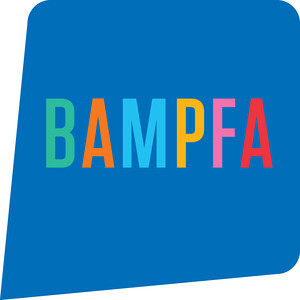March 2–November 7, 2015
MATRIX 258 features the work of artist and electroacoustic composer Tarek Atoui (b. 1980). Born in Lebanon and based in Paris, Atoui initiates and curates multidisciplinary interventions, concerts, performances, and workshops. His work often radiates around large-scale, collaborative performances that develop from extensive research into the history of music and instrumentation, while also exploring new methods for production. Using custom-built electronic instruments and computers, Atoui articulates social realities and histories in his work, while presenting music as a powerful mode of expression and identity. His MATRIX exhibition is the final installment in BAMPFA’s series of nomadic projects before it opens its new building in downtown Berkeley on January 31, 2016.
Organized in conjunction with the Experimental Media and Performing Art Center (EMPAC) at Rensselaer Polytechnic Institute (RPI) in Troy, New York, Atoui’s MATRIX project is a continuation of his recent exploration into how sound is perceived by both the hearing and nonhearing. His MATRIX project began in March 2015, when Atoui spent three weeks at UC Berkeley coteaching an instrument-making seminar with art professor Greg Niemeyer, with the ultimate goal of realizing some of these new instrument designs. As part of this first phase, Atoui gave a lecture at the David Brower Center introducing his research and engagement with deaf communities and performed a concert at Meyer Sound’s acoustically sophisticated Pearson Theater. The second and final phase of MATRIX 258 comprises a series of concerts on November 5 and 7, at the Mills College Student Union and UC Berkeley’s Hearst Memorial Mining Building, respectively, that will premiere the new instruments. Performers include Bay Area new music luminaries such as James Fei, William Winant, as well as Mills and UC Berkeley students, and others.
Over the past several years, Atoui has researched the relationships among sound, vibrations, instruments, and the body. This inquiry led to WITHIN, Atoui’s contribution to the Sharjah Biennial 11 (2013), which grew out of a 2008 residency at the Sharjah Art Foundation. As part of the project, Atoui conducted workshops at the Al Amal School for the Deaf. His research there revealed that the deaf students’ favorite musical instrument was the drum, due to the vibrations it produces and its physical potential. For WITHIN, Atoui invited an international assembly of experimental drummers, including Brian Chippendale, Susie Ibarra, Yoshimi, and others, to perform in strategically located public squares and rooftops throughout the city that possessed optimal sonic qualities for deaf people. For another part of WITHIN, Atoui worked with the students to compose and perform a work based on infrasonic frequencies, or those below 160 hertz (Hz), that are primarily perceived through touch.
Continuing along this theme, Atoui has developed new instruments for his MATRIX project, WITHIN 2. The first of these instruments, Zero Point Nine, was made in collaboration with Greg Niemeyer, Perrin Meyer of Meyer Sound, Jeff Lubow from Berkeley’s Center for New Music and Audio Technologies (CNMAT), and UC Berkeley sophomore Mitchell Karchemsky. It is in essence a monumental bass synthesizer that produces ultra-low-frequency electronic sounds that are physically felt, perhaps even before they are heard. For the November concerts performers will activate several connected subwoofer speakers to create a subsonic experience variously perceptible to deaf and hearing members of the audience.
The SuperPac, the second instrument Atoui developed for MATRIX, is a percussive instrument played by one or more musicians in front of a small audience. Soft, SubPac speakers press against the audience members’ backs as they are seated and generate a physical experience rooted in felt vibrations. These speakers connect electronically to a computer station and to a set of tables that have unique surfaces that can be played like a drum with objects such as mallets or sticks. A conductor stands at the computer station to control the sensorial connections between the performers and the audience.
In January 2016, WITHIN 2 continues at EMPAC in Troy, New York, where he will work with the pioneering musician and music professor Pauline Oliveros to engage RPI students in designing and building additional instruments and interfaces for performance. The entire project will culminate at the Bergen Assembly 2016, a citywide series of performances, workshops, events, and lectures Atoui will organize in Norway, working with local institutions, musicians, artists, and audiences centered on his expanded exploration of sound with deaf communities.
Public programs
Concerts: WITHIN 2
Concerts premiering instruments for hearing and nonhearing audiences alike created by artist Tarek Atoui in collaboration with UC Berkeley faculty, students, and Meyer Sound. With local musicians William Winant, James Fei, and others.
Concert 1: Thursday, November 5, 6pm
Mills College Student Union
Concert 2: Saturday, November 7, 4pm
Hearst Memorial Mining Building, UC Berkeley
Concert 3: Saturday, November 7, 6pm
Hearst Memorial Mining Building, UC Berkeley
Free for Mills College and UC Berkeley students.
Limited seating available
Panel discussion: Saturday, November 7, 5pm, Hearst Memorial Mining Building, UC Berkeley
Featuring Tarek Atoui, Perrin Meyer, Greg Niemeyer and Jeff Lubow, moderated by Apsara DiQuinzio
Support
Tarek Atoui / MATRIX 258 is organized by Apsara DiQuinzio, curator of modern and contemporary art and Phyllis C. Wattis MATRIX Curator. It is copresented with the Curtis R. Priem Experimental Media and Performing Arts Center (EMPAC). The MATRIX Program is made possible by a generous endowment gift from Phyllis C. Wattis and the support of the BAMPFA Trustees. Major support is provided by Meyer Sound. Additional support is provided the Berkeley Center for New Media (BCNM).
Press contact: Peter Cavagnaro, pcavagnaro [at] berkeley.edu

